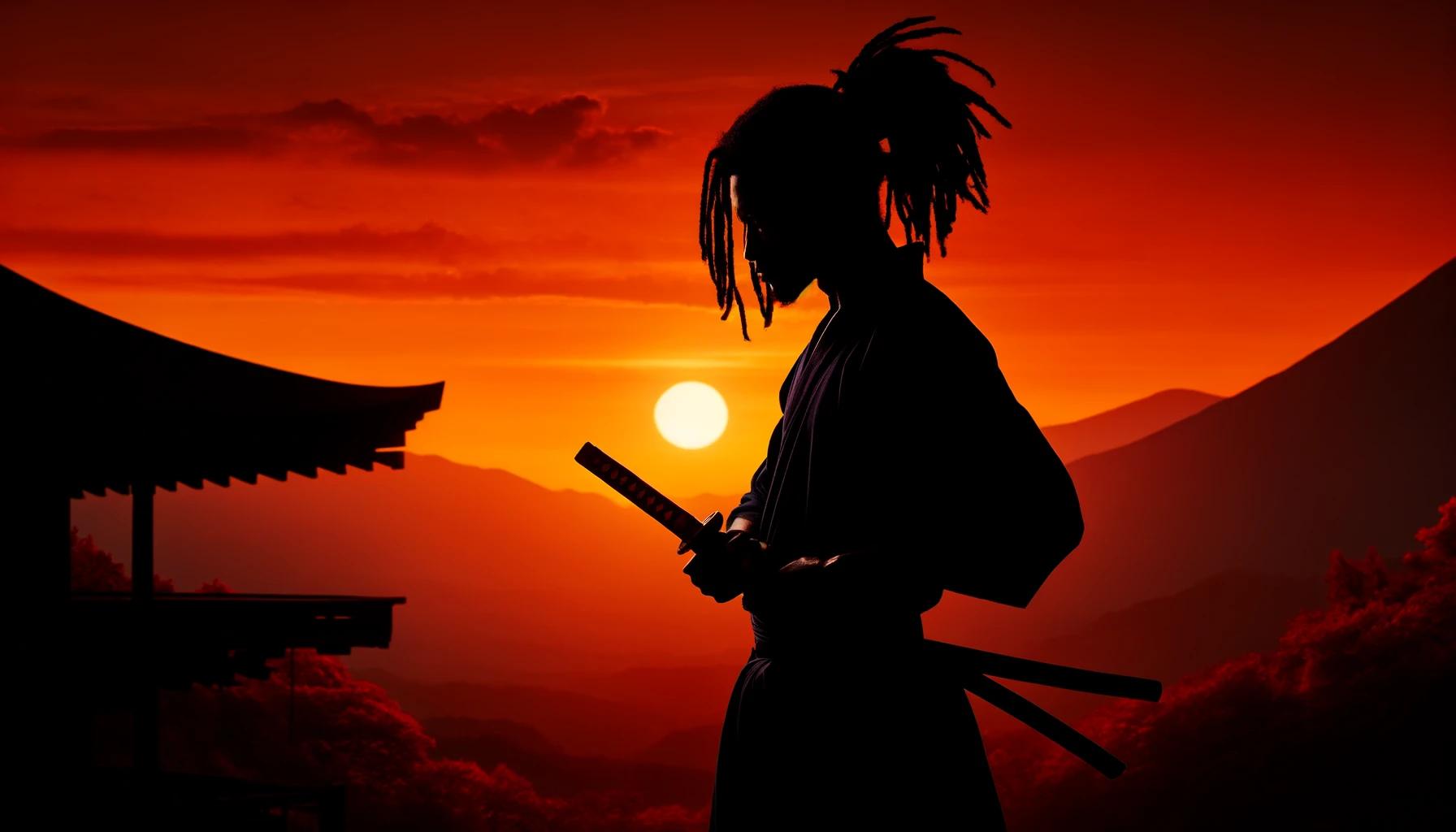Have you heard of Yasuke, a black man who arrived in Japan in the 16th century? Yasuke was a slave brought by Jesuit missionaries. Oda Nobunaga, a prominent Japanese warlord, found him fascinating, made him a retainer, and kept him close. Nobunaga had a penchant for embracing the new and unusual. He introduced firearms aiding his military conquests, and protected foreign Christianity, highlighting his progressive nature.
Nobunaga’s curiosity and proactive approach made him a famous warlord. Toyotomi Hideyoshi came from a poor peasant family, but he gained Nobunaga’s favor and went on to unify the country after his death. At a time when Westerners enslaved black people, Nobunaga’s decision to make Yasuke his retainer speaks volumes about his character and his unique way of thinking. Even today, we might learn from Nobunaga’s open-mindedness.
Now, Yasuke is set to be a protagonist in the next Assassin’s Creed game, sparking worldwide debate. Let’s explore why this is controversial and the misconceptions about Yasuke that have spread internationally.
- The Latest Assassin’s Creed
- Main Reasons for Criticism
- My Opinion: Too Soon to Criticize Yasuke’s Inclusion, but Questioning His Legendary Samurai Status Is Fair
- Japanese Reactions
- Primary Sources on Yasuke
- Fabricated History by Thomas Lockley
- Lockley’s Speculative Nature from His Interview
- Historical Revisionism Is Not Just Ubisoft’s Problem
- Japanese Indifference to Historical Revisionism
- Was He a Samurai? My Thoughts on Yasuke
- My Expectations for Assassin’s Creed Shadows
The Latest Assassin’s Creed
The trailer for the new game features Yasuke, a black samurai, and Naoe, a female ninja. It depicts Naoe’s hometown being burned. In history, Oda Nobunaga burned down Koga, the land of ninja, and Akechi Mitsuhide burned down Honno-ji Temple and Nobunaga committed seppuku. The Assassin’s Creed series already has a storyline where a ninja assassin named Yamauchi Taka kills Nobunaga and Hideyoshi.
Based on this, the game’s story might revolve around Naoe seeking revenge for her village (Assassin side) and Yasuke avenging Nobunaga’s death (Templar side). If this is accurate, their opposing forces and relationship dynamics will be intriguing.
Main Reasons for Criticism
A Black Samurai Protagonist Instead of a Native Japanese
This surprises many foreigners who find it hard to believe there were black people in 16th-century Japan. However, in reality, Yasuke was brought to Japan by missionaries during Nobunaga’s time. Later, during Ieyasu’s era, a white man named William Adams washed ashore in Japan and became a samurai known as Miura Anjin(三浦按針). While Yasuke did come to Japan, there is no historical evidence that he was a samurai, leading to claims of historical revisionism.
Using Japanese History for Political Correctness
Critics argue that Yasuke’s inclusion is driven by a modern emphasis on political correctness. Ubisoft’s push for diversity is commendable, but applying it to a historical game raises questions about accuracy. Just a year ago, there was a major controversy when a Black actress played Cleopatra in a Netflix docudrama, despite historical evidence suggesting Cleopatra wasn’t Black. Nowadays, with historical facts often being altered, many people would likely be disappointed to see a Black samurai.
Sudden Focus on a Historical Figure
Previous Assassin’s Creed protagonists were not historical figures. Suddenly making Yasuke the protagonist feels odd, suggesting the game might be emphasizing a “legendary black samurai” narrative for their political purposes.
My Opinion: Too Soon to Criticize Yasuke’s Inclusion, but Questioning His Legendary Samurai Status Is Fair
While I share concerns about modern political correctness, Yasuke’s unique story offers a fresh perspective in the game. Given the Assassin’s Creed setting, Yasuke could become a unique character who offers a fresh perspective. As a former slave to Jesuit missionaries (likely the Templars in the game) who served the powerful Nobunaga, his story could be fascinating. Nobunaga, who will be killed by an Assassin, adds another layer of intrigue. Incorporating Yasuke could lead to a compelling narrative. Criticizing his inclusion should wait until the game’s release.
However, portraying Yasuke as a samurai deviates from historical facts. After the Honno-ji Incident, Yasuke returned to the Jesuits, and his later history is unknown. The depiction of him in samurai armor is likely influenced by the fictionalized narrative of Yasuke as a legendary black samurai, which is problematic.
Japanese Reactions
Initially, Japanese audiences welcomed Yasuke’s inclusion. A black retainer of Nobunaga is unique and interesting. However, many are uncomfortable with Ubisoft’s comments, poor historical research, and the spread of false history about Yasuke overseas.
Reasons Japanese People Are Angry
Ubisoft’s Interview Comments
If Ubisoft had simply included Yasuke, there wouldn’t be much anger. However, in an interview with Famitsu, Japan’s most famous gaming magazine, Ubisoft explained that Yasuke was chosen because they wanted an “our samurai.”
弥助については、まず “私たちの侍”、つまり日本人ではない私たちの目になれる人物を探していましたが、これは当初からポルトガル入渡来にまつわるストーリーが、日本の危機を語る際に非常にすぐれた方法だと考えていました。チームはこの弥助というキャラクターを気に入ってくれましたし、彼を使って日本を発見することが期待できると考えました。
Translation:
https://www.famitsu.com/article/202405/5194
As for Yasuke, we were first looking for “our samurai,” someone who could be our non-Japanese eye. From the beginning, we thought that the story of his arrival in Portugal was a very good way to talk about the crisis in Japan. The team liked this character and thought that we could use him to discover Japan.
Some Japanese felt it discriminatory, because it can be interpreted as the production team are able to sympathize with Black people but not with Japanese people. This statement has been deleted later.

However, I hope that this statement meant that Yasuke, a slave to Jesuit missionaries who served a powerful figure, can seamlessly fit into the previously Western-centric world of Assassin’s Creed.
Poor Historical Research on Culture and Architecture
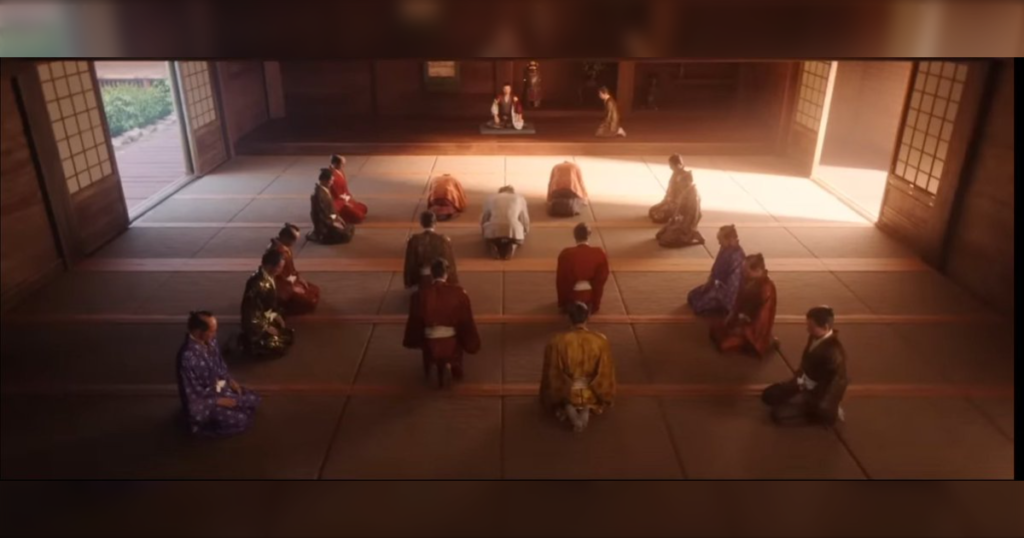
Assassin’s Creed is known for meticulous historical research. It’s even been used as an educational tool and aided in the restoration of the burned Notre Dame Cathedral. Ubisoft’s level designer spent two years ensuring historical accuracy down to each stone. Compared to them, the depiction of Japanese culture and architecture has mistakes. Even this just a brief scene has many errors:
- Square tatami mats
- Incorrect seams on tatami mats
- Sitting across tatami mat seams
- Tatami mats were not used in this period; it was wooden flooring
- A retainer is sitting in the same place as Nobunaga
- Oversized shoji screens
These mistakes suggest a lack of respect for Japanese history and culture.
Spread of False History
The biggest issue is the spread of false history about Yasuke. In Japan, Yasuke is known as a slave brought by missionaries who intrigued Nobunaga. Abroad, a fictional narrative of Yasuke as a legendary black samurai, or a worshipped deity has spread. The official Assassin’s Creed X account also refers to Yasuke as a “historical legend.”
Primary Sources on Yasuke
There are only three primary sources on Yasuke, each with just a few lines.
弥助(Yasuke)が伝説の侍だと思っている外国人さん。彼に関する資料のほぼ全ては2分以内で読めるのでノンフィクションをうたうトーマス・ロックリーの分厚い小説を信じるのは止めてもらいたい。
1.イエズス会日本年報 2.家忠日記 3.信長公記
Translation:
To the foreigners who believe Yasuke was a legendary samurai: almost all of the historical documents about him can be read in under two minutes. So, I want you to stop believing Thomas Lockley’s thick book that claims to be non-fiction.1.Jesuit Japan Annual Report 2.Ietada Diary 3.Nobunaga Chronicle
https://twitter.com/laymans8/status/1792028957283610935
Here are the English versions of these materials that I translated:
Jesuit Japan Annual Report (イエズス会日本年報)
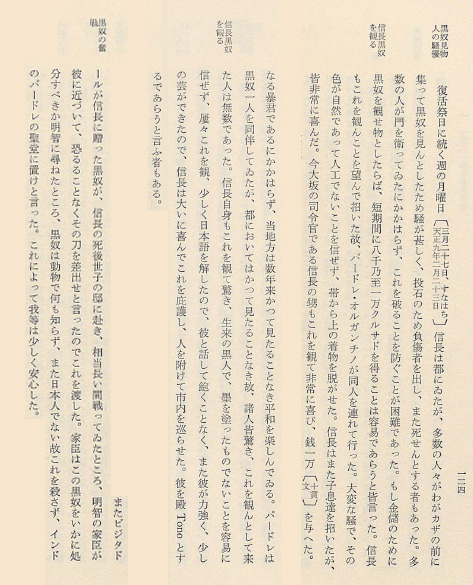
Translation:
––– Jesuit Japan Annual Report (Iezusukai Nihon NIppō)
On the Monday following Easter [March 27, which was February 23 in the 9th year of Tensho], Nobunaga was in the capital. A large crowd gathered in front of our monastery to see the black slave, causing such a commotion that some people were injured or even left for dead by thrown stones. Despite the presence of many guards at the gate, it was difficult to prevent the crowd from breaking through. Everyone said that if put the black slave on show for profit, it would be easy to earn eight thousand to ten thousand cruzados in a short time. Nobunaga was also eager to see the black slave, so he summoned him, and Padre Organtino brought him. Nobunaga caused a great commotion and stripped him of his upper garments because he did not believe that his color was natural and not artificial. Nobunaga invited his sons, and they all were greatly pleased. Nobunaga’s nephew, who is now the commander of Osaka, also saw it and was so delighted that he gave him ten thousand coins [ten kanmon].
Translation:
––– Jesuit Japan Annual Report (Iezusukai Nihon NIppō)
The Padre was accompanied by a black slave, who was being seen in the capital for the first time, and everyone was astonished. Countless people came to see him. Nobunaga himself was surprised when he saw him and found it hard to believe that he was naturally black and not painted with black ink. He observed him frequently and, since the black slave understood some Japanese, Nobunaga never tired of talking to him. Additionally, because the man was strong and able to perform some tricks, Nobunaga was very pleased and took him under his protection, assigning a retainer to accompany him around the city. Some people even said that Nobunaga might make him a Tono(lord).
Translation:
––– Jesuit Japan Annual Report (Iezusukai Nihon NIppō)
After Nobunaga’s death, the black slave who had been presented to Nobunaga by the Visitador went to the residence of Nobunaga’s heir. He fought for a long time until one of Akechi’s retainers approached him and told him to surrender his sword without fear. He then handed over his sword. A retainer asked Akechi how to deal with the black slave. Akechi ordered that the black slave should not be killed because he was an animal, knew nothing, and was not Japanese, and that he should be placed in the church of the padres from India. This brought us some relief.
Ietada Diary (家忠日記)
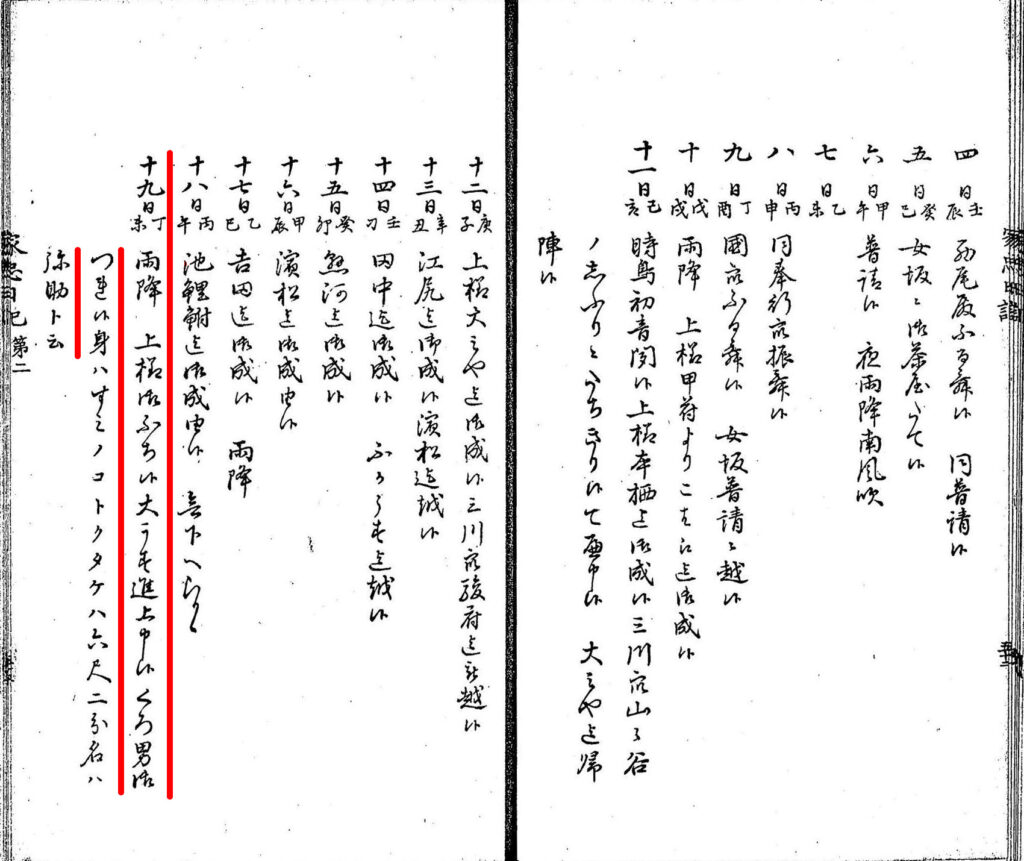
Translation:
––– Ietada Diary (Ietada Nikki)
On the 19th (of April,) 1586, it rained. The lord (Nobunaga) took with him a black man, who has been given provisions by Nobunaga and presented by the missionaries. His body was like black ink, standing at six shaku and two bu (approximately six feet), and his name was Yasuke.
Nobunaga Chronicle (信長公記)
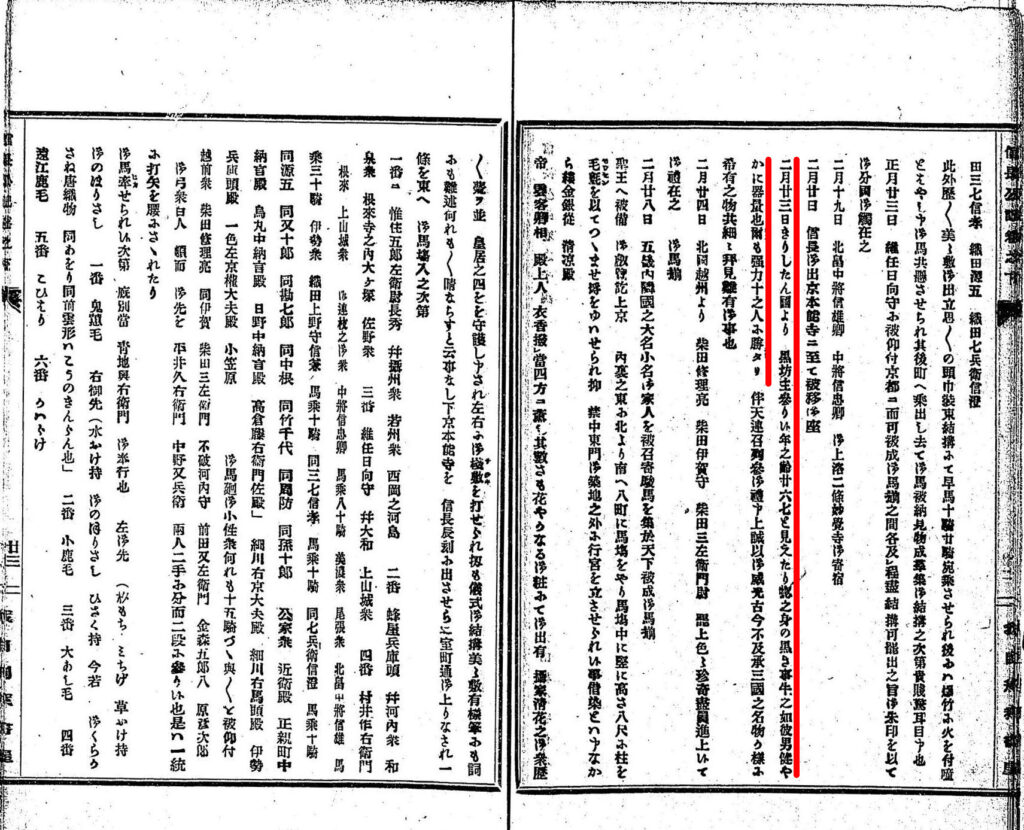
Translation:
––– Nobunaga Chronicle (Shinchō Kōki, or Nobunaga Kōki)
On February 23, a black monk arrived from the Christian country. He appeared to be around 26 or 27 years old, with a body as black as a cow’s. This man had a imposing physique and was extraordinarily strong, with the strength of more than ten men.

“黒坊主” can be translated as either “black monk” or “black man.”
It is said that a manuscript held by the Sonkeikaku Bunko (尊経閣文庫) mentions that Yasuke was given a residence and a short sword, and sometimes served as a porter. However, I haven’t had access to this manuscript myself.
Fabricated History by Thomas Lockley
Despite limited sources, there are no records of Yasuke being a legendary black samurai. This narrative seems to stem from the speculative works of Thomas Lockley, whose book “African Samurai” has influenced the spread of this fictional history.
Thomas Lockley
Thomas Lockley, An Englishman and currently an associate professor at Nihon University, originally specialized in linguistics. Recently, however, he has published numerous books and papers on Yasuke, many of which are not peer-reviewed.
Thomas Lockley’s Book
Many claims about Yasuke being a legendary samurai are based on Lockley’s book, “African Samurai: The True Story of Yasuke, a Legendary Black Warrior in Feudal Japan.” Despite the limited historical records, this book has as much as 400 pages, raising suspicions that much of it is fictional.
Lockley’s Speculative Nature from His Interview
I haven’t read the book, so I’m not criticizing its content, but from his CNN interview, it’s clear that he tends to speculate and make associations easily.
Oda believed Yasuke to be either a guardian demon or “Daikokuten,” a god of prosperity usually represented by black statues in temples. He tried to rub the pigment from Yasuke’s skin, believing it was black ink. Once convinced Yasuke was real, he immediately threw a feast in his honor, says Lockley.
https://edition.cnn.com/2019/05/19/asia/black-samurai-yasuke-africa-japan-intl/index.html
In the historical record, while it is noted that “Nobunaga stripped him of his upper garments because he didn’t believe his color was natural,” there is no mention of “He believed Yasuke to be either a guardian demon or ‘Daikokuten’” or “immediately threw a feast in his honor.”
If you tell Japanese people that Yasuke was worshipped as Daikokuten, they would be puzzled. According to the Jesuit Japan Annual Report above, Akechi Mitsuhide treated Yasuke like an animal, saying, “The black slave is an animal and knows nothing; he is not Japanese, so don’t kill him, place him in the Padre’s church in India.” If Yasuke was really considered a deity like Daikokuten, would Mitsuhide say such a thing? Why would a deity be brought to Japan as a slave by Christian missionaries? Such speculation mocks the discernment of the Japanese people of that time.
Confusion with “White Gods”
The idea that Japanese people saw a black man and thought of Daikokuten is not our Japanese notion. Daikokuten is one of the Seven Lucky Gods. In a polytheistic culture like Japan’s, it’s unlikely that people would regard a black person as a revered god just because of their skin color. Lockley might have associated Yasuke with the historic episode; Aztec people believed in “white gods” and mistook the arriving Spaniards for gods due to their white skin, leading to being conquered easily. The idea that Japanese people also mistook other races for gods due to skin color is just a speculation by a fanciful Western researcher, typical of regions where monotheism is common.
Historical Revisionism Is Not Just Ubisoft’s Problem
While Ubisoft’s portrayal of Yasuke is criticized for historical inaccuracy, the root cause lies in the difficulty Westerners face in accessing Japanese sources. This reliance on Lockley’s speculative work has led to the game’s errors. This is no longer a gaming issue; it’s a matter of historical study. We Japanese might be at fault for not stopping him from promoting his speculation and false version of history.
Japanese Indifference to Historical Revisionism
Even before the controversy surrounding Yasuke, there have been attempts to alter many aspects of Japanese culture and history. Korea often claims that various aspects of Japanese and Chinese culture originated from Korean culture. The Wikipedia page “List of Korean Claims of Origin” includes claims that samurai, ninja, and katana, all of which appear in Assassin’s Creed Shadows, are actually of Korean origin.
- A Wikipedia page explains that it was once claimed that the Korean term Ssaurabi was the origin of the word samurai.
- A clip explains the fictional history of the Korean Ninja
- A Reddit question asks, “Is it true that the katana was invented in Korea?”
Many Japanese tend to be optimistic about these problems, thinking, “Historical facts won’t change.” However, there are forces attempting to alter history, and books promoting false narratives, like “African Samurai,” have been published. These books’ claims are quoted in news articles and academic papers, creating a chain of misinformation that even appears in games. A few months ago, an AI-generated image of black samurai went viral, and some people believed they were real.
Japanese people should be more aware of the dangers of their history being altered. It’s disappointing that while overseas fans of Japan are raising their voices against the alteration of Japanese history, the Japanese themselves remain indifferent.
Was He a Samurai? My Thoughts on Yasuke
The debate about Yasuke being a samurai is often discussed overseas. It is less important to me, but my perspective is that, while historically inaccurate, calling Yasuke as a samurai metaphorically is acceptable. I will explain the term “samurai” using this website as it provides very detailed information.
What Is a Samurai?
The term “samurai” originates from the verb “saburau,” meaning “to serve.” The definition evolved over periods.
Difference Between Samurai and Bushi
While “bushi” is an umbrella term meaning “warrior,” “samurai” refers to a warrior who serves a master. Regardless of martial prowess, a bushi without a master isn’t called a samurai.
Definition of Samurai
- Heian Period: Officials serving nobles
- Mid-Heian Period: Local warriors becoming samurai
- Kamakura Period: Lords with territories
- Muromachi Period: Warriors following the Ashikaga clan
- Sengoku Period: The definition became ambiguous, and anyone fighting in battles was called a samurai
- Edo Period: Warriors above hatamoto status
Yasuke as a Metaphorical Samurai
In the Sengoku period during which Nobunaga lived, anyone fighting in battles was considered a samurai. Yasuke, after Nobunaga’s death, fought for his successor, making himself a respectable “samurai” in that context, even though he would not have been a formal bushi who fought on the battlefield.
He was never the black armored warlord depicted in the game, but he was a black man tossed by fate. He crossed from Africa to India and eventually to Japan as a slave. He was a tragic “samurai” who lost his lord who had valued him.
My Expectations for Assassin’s Creed Shadows
It’s not right to alter history and portray Yasuke as a historical legendary samurai. I want Ubisoft to emphasize that this game is a fiction and stop using the word “historical.”
However, it’s worth considering what he saw and thought in Japan. I hope Assassin’s Creed Shadows portrays those aspects of his inner life.
